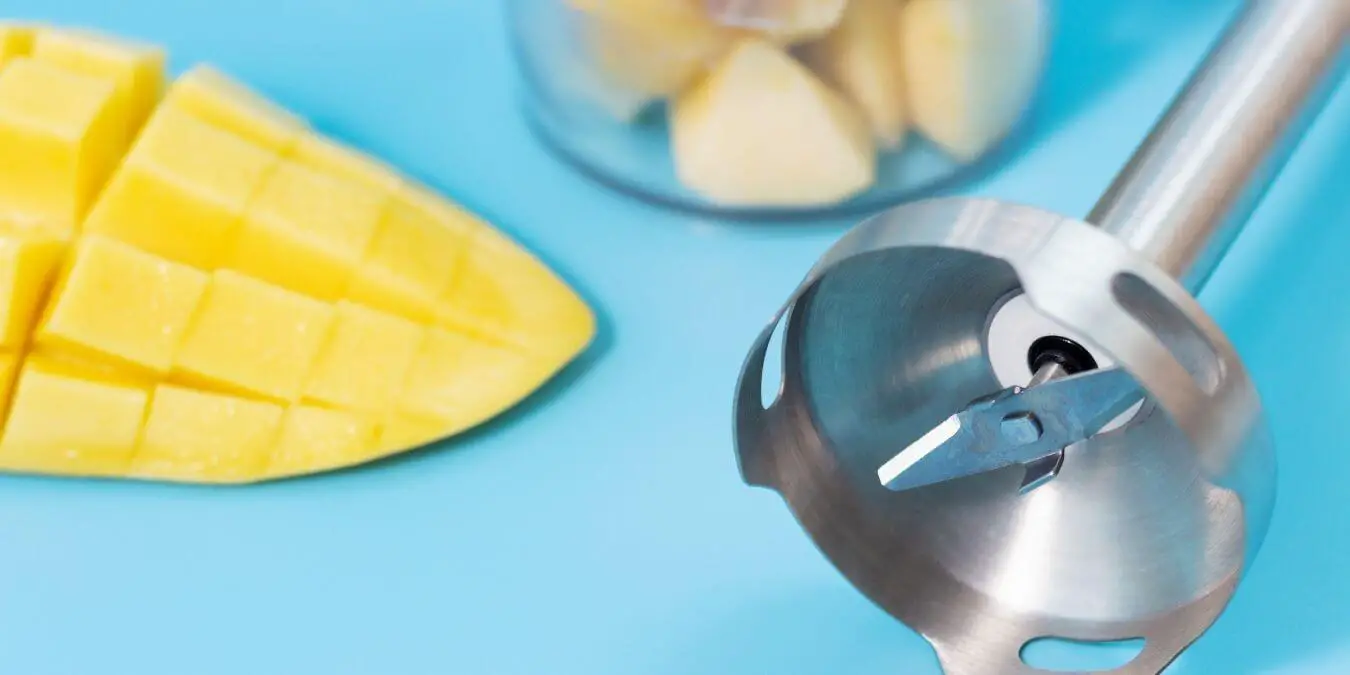People love immersion blenders. They are small, powerful and have many uses in the kitchen. But what are you to do if you are working without an immersion blender and a recipe states to use one? Instead of an immersion blender, you can turn to other tools you might have available in your kitchen right now.
There are many substitutes for immersion blenders. Which one will work best depends on your needs. Instead of an immersion blender, you could use:
- Blender
- Electric Whisk
- Food Mill
- Food Processor
- Hand Mixer
- Potato Masher
- Ricer
- Stand Mixer
- And more…
As handy as immersion blenders are, you don’t need one. People made soups, sauces, and smooth pesto well before immersion blenders hit the scene. So don’t panic if yours broke or you’ve never owned one. Nor do you need to rush out and buy one so that you can try a new recipe or finish making a meal. We’ve got 10 suggestions to help you out.
10 Best Immersion Blender Alternatives
Sometimes you have to make do without an immersion blender. So to help you out, we’ve rounded up our top 10 alternatives to using an immersion blender. What works best for you will depend on two things:
- Do you own it?
- What are you making?
In other words, all you need to do is determine if you own the tools or kitchen appliances suggested and figure out if it will work for what you’re making. In regards to what you’re making, alternatives have their strengths and weaknesses. For example, what works best for mashed potatoes may not be the top choice for blending a pureed soup.
1 – Blender
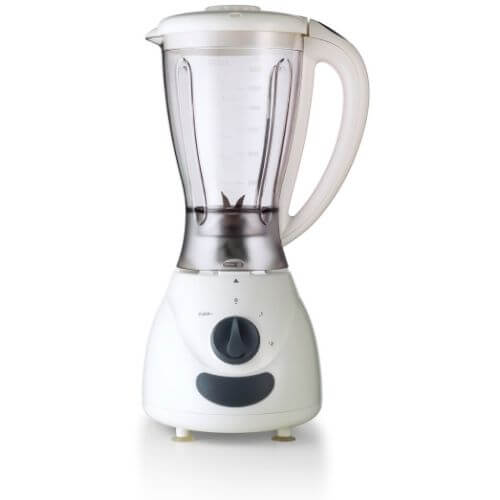
Before immersion blenders, there was the blender. Yes, these once were used for more than mixing up a batch of margaritas. These things can do everything an immersion blender can, with higher speed and a stronger blade. However, they are not as convenient. But there is a lid, which prevents you from redecorating the ceiling. If you need to blend something well and don’t have an immersion blender, look no further.
Blenders are the best substitute for immersion blenders in most cases. The strong blades and motor can puree frozen fruits and anything that needs high speed blending. The downside to using a blender is that it takes up more space and requires more cleaning than an immersion blender.
Pros
- High speed
- Meant for blending
- Has lid (prevents liquid splashes)
Cons
- Must pour in and back out
- Another thing to wash
- Can be expensive
2 – Chopper
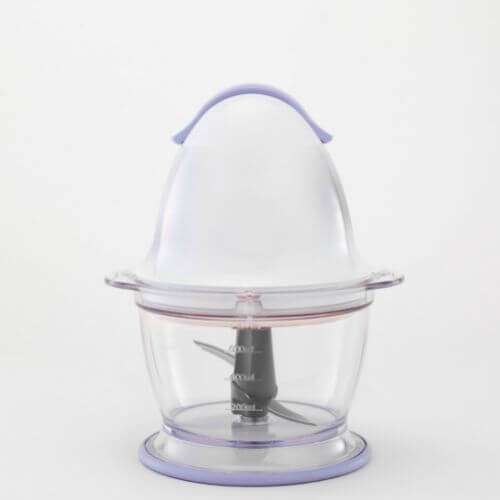
Chopper bowls are typically used for salads or preparing nuts for baking. Really anything that you want to, well, chop! If you have a manual chopper, it’s a good immersion blender substitute for making things like chunky salsa. However, you’ll find it hard to make a smooth soup or pesto with a chopper unless it is electric.
Pros
- Inexpensive
- Can serve directly from some dishes
- Excellent for dishes such as chunky salsa
- Electric choppers are good for soups, pesto, and baby food
Cons
- Manual effort (if not using electric version)
- May need a separate bowl
3 – Electric Whisk

Electric whisks are an excellent immersion blender alternative when stiffening egg whites, whipping cream, or making frosting. A handheld one is best, as you can use it directly in the bowl. However, get the angle right, or it can shower you, your walls, countertops, and ceiling.
However, most electric whisks are not sold on their own but as an attachment to other appliances such as:
- Food processor
- Hand mixer
- Immersion blender
- Stand mixer
Pros
- Perfect for stiffening egg whites, whipping cream, and making frosting
- Don’t need another bowl when handheld
- Usually free with another kitchen appliance
Cons
- May require a separate bowl
- Difficult to purchase on its own
- Not recommended for heavier jobs
4 – Food Mill
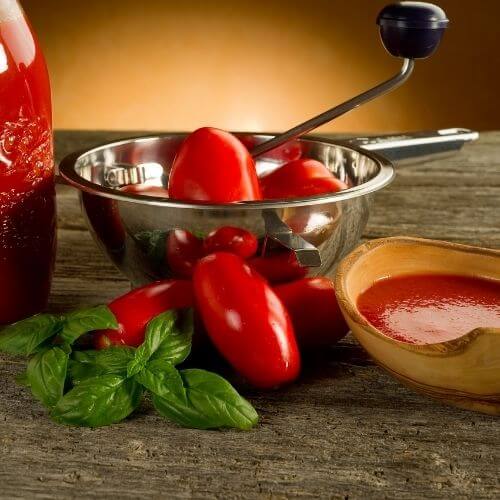
Food mills were developed in the 1920s, well before blenders and food processors came on the scene. This was how you made smooth soups, apple sauce, mashed potatoes, and baby food. They were still prevalent in the 80s because they handled high heat, and many stand blenders would crack at the sight of hot soup.
These things are brilliant if you are going off-grid. They are durable, can handle large quantities at once, and need no electricity. They also don’t require as much strength as other hand options. So much so, kids would often gladly volunteer to do this job as turning the crank is kind of fun, and watching purred food come out of the holes is highly amusing when you’re five.
Pros
- Handles high heat
- Durable
- Large quantities at once
- Kind of fun, so kids volunteer to help
- Reasonably priced
Cons
- Hand powered
- Another item to wash
5 – Food Processor

Food processors are strong, and are generally favored for tougher things such as nuts or making large batches of hummus. However, they can be useful for making guacamole, smoothies, and pureeing soup. The sharp blades of a food processor can puree, chop, emulsify and blend pretty well.
However, the more liquid involved, the more likely it can splatter. While food processors usually have a stopper to cover the feeder hole, it can still leak out where the lid meets the bowl. So, it is best to do it in small batches.
Pros
- Strong and fast
- Can do most immersion blender jobs
- Large batches
Cons
- Not great for stiffening egg whites and whipping cream
- High liquid foods can leak out if not done in small batches
- Expensive
- A lot of extra washing
6 – Fork

Forks are your original masher. Forks can get the job done, from mashing potatoes to mushing up steamed vegetables for a baby. Another great use for a fork is to mix eggs before scrambling. A downside is it’s not easy to whip cream or purée soup.
Pros
- Probably already own one
- Needs no electricity
- Don’t need an extra pot
- Little to no extra washing
Cons
- Laborious
- Slow
- Don’t produce as smooth of a result
- Limited jobs
7 – Hand Mixer
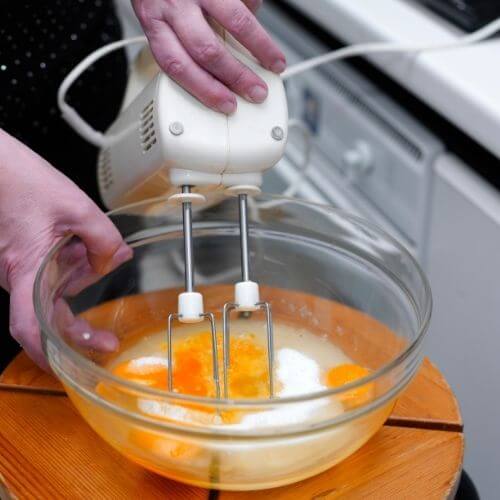
Hand mixers (a.k.a. hand blender or hand mixer) can be inserted directly into a pot to make soups, frosting, whipped cream, mayonnaise, and even creamy mashed potatoes. In fact, they often produce fluffier results. However, while they are not as volatile as an electric whisk, they can spray if angled wrong.
You can use a hand mixer instead of an immersion blender for many things. But recipes calling for purees or for something to be fully blended may not turn out the same using a hand mixer. In comparing hand mixers vs immersion blenders, hand mixers work best when you blend something that is pretty well cooked already (as opposed to frozen or tough).
Pros
- Can use directly in a pot
- Affordable
- Produce fluffy whipped cream and frosting
Cons
- Can spray
- Not great if you want a choppy result, like chunky salsa
8 – Potato Masher
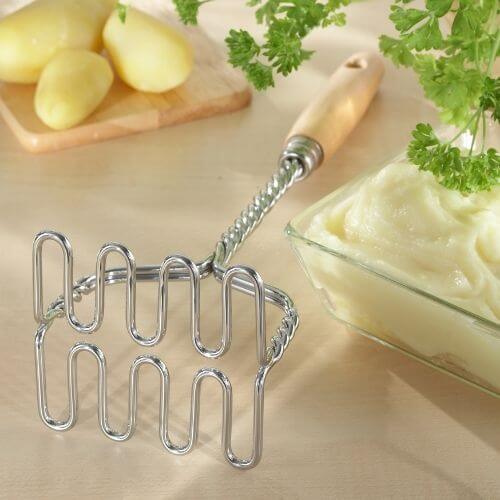
Potato mashers are inexpensive, easy to use, and don’t require an extra pot. However, they are not great for plunging into soups or making a smoothie. Getting a completely smooth texture using a potato masher can be hard to do. But using one for fully cooked, soft foods works well.
Pros
- Inexpensive
- Put directly into a pot
- Easy washing up
Cons
- Manual labor
- Don’t do much other than mash
- Will not produce a smooth result to mashed foods
9 – Ricer
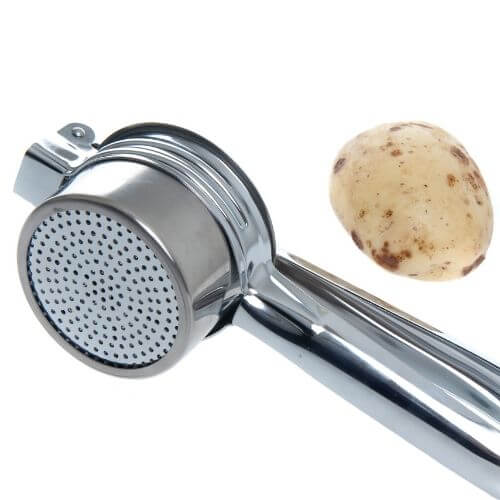
Ricers are like potato mashers but produce a much smoother result. They are also excellent for squeezing water out of spinach and shredded zucchini. Many can be fastened to the pot, which is handy. However, they do require some grip strength.
Pros
- Inexpensive
- Don’t create much extra washing
- Smooth results
- Squeeze out excess water
Cons
- Limited jobs
- Require good grip strength
- Time-consuming for large batches
10 – Stand Mixer
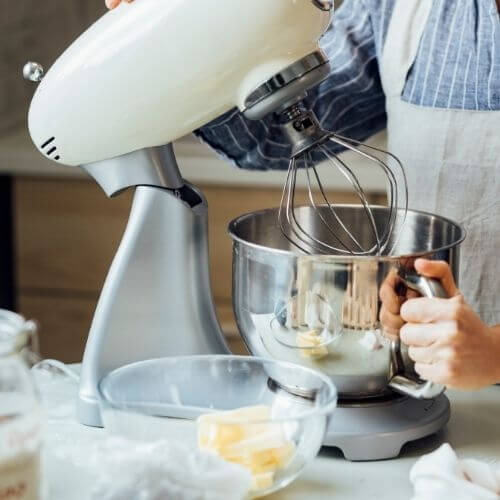
Stand mixers are powerful and fast. They can whip cream, mix batter, and stiffen egg whites in a blink. But they can be messy for soup and require you to transfer the food into a separate bowl. Stand mixers work very well for making batters or dough. They don’t work too well if you are looking to blend or puree at a high speed.
Pros
- Strong and fast
- Excellent for whipping cream, mixing batter, and stiffening egg whites
Cons
- Expensive
- Must transfer food in then back out
- Can be messy for food with high liquid content
Conclusion
Immersion blenders are fantastic kitchen appliances, but there are plenty of alternatives, from hand mixers to forks. The trick is looking at what you have and then deciding which of those options best suits the recipe. Bon appétit.
